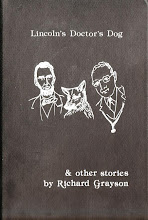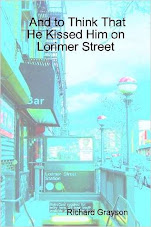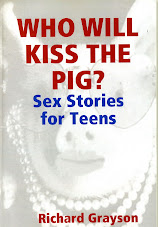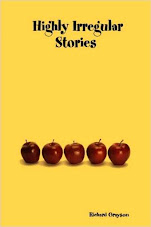
We went back to the fabulous Changing Hands Bookstore in Tempe for the second evening event in a row, and we're glad we did.

Michael Montlack, whose poetry we've admired for years, gave a wonderful reading from and talk about the well-received anthology he conceived and edited, My Diva: 65 Gay Men on the Women Who Inspire Them.

Like last night's event, it drew a smallish (about twenty) but enthusiastic crowd, including Big Bird sitting in the back row. We all pretty much adored Michael's talk about how he came to create My Diva and his readings, assisted by a friend, of not just his own essay but those of several wonderful writers who are among his 65 contributors.

The book has received wonderful notices, such as this rave in Publishers Weekly:
In very short, very tender essays, a variety of gay male writers, from poets to playwrights to a standup comic, pay homage to an even wider variety of women who have inspired them. Peter Dubé writes how the photography of Claude Cahun suggested "a delirious world of possibilities"; Jeff Oaks recalls a childhood of wearing wristbands fashioned from paper cups to emulate his "model of power," Wonder Woman; Christopher Lee Nutter looks back on his closeted teenage years and how Sade taught him "that there was a world somewhere that suited them better than the world they'd been born into"...such standout pieces as Mark Doty on Grace Paley are elegant and affectionate tributes to how these muses have been "fairy godmothers" and "older sisters," as Montlack's introduction explains, and illustrate how complex, sustaining and lifelong are the bonds between gay men and their divas.

And Library Journal:
The essays, mostly three to five pages, are touching and thoughtful as well as funny, as they lovingly detail what each author's personal diva has meant to him. Show business and popular culture icons abound, with most of the usual suspects present (Liza, Marlene, Cher, both Bettes, and Joan), as well as choices from history and politics (Elizabeth I, Eva Perón), the culinary arts (Julia Child, Jennifer Patterson), and even fictitious figures (Auntie Mame, Princess Leia, Endora)...This is one of those delightful books you can open at random and be amused, enlightened, or moved by.

Michael, who divides his time between New York City, where he'a an English professor at Berkeley College, and San Francisco, discussed how he came up with the idea of the book, a departure from his work in poetry (his chapbooks include Girls, Girls, Girls, The Slip and Cover Charge).

He found that nearly all the gay male writers he solicited as contributors were immediately excited about the idea of writing about their personal divas; their only concern was that someone else might reserve her first. It turned out there were few overlapping requests. There's a diva for everyone, it seems.

After discussing how the book was put together, Michael read his own essay on his diva, Stevie Nicks, whom he's loved since viewing her on MTV in the early 1980s during his Long Island childhood.

The essays Michael read are fairly brief but interestingly varied. Surprisingly, the most stereotypical divas -- the trinity of Judy, Barbra and Madonna -- were not among them, but there were some fascinating choices. (Michael said he got a little grief early on for having such a "non-traditional" diva as Stevie Nicks.) For example, "Heart of a King" by Patrick Letellier is an appreciation of what the author admits is a "nerd's diva," Queen Elizabeth I.

RJ Gibson's penetrating look at Annie Lennox takes off from her legendary appearance with the Eurythmics at the 1984 Grammy Awards ("Mom, is that a guy?") and evolves into a meditation on androgyny.
We especially liked the unconventional selection of the brilliant and underrated comedian Margaret Dumont in Christopher Murray's "The Duchess of Dignity," which has brilliant insights about the Marx Brothers' straight woman as a role model for how a ridiculed outcast can maintain her power and grace.

And delicious is the first word we can think of for one of the essays on a fictional diva (others in the book include Princess Leia and Auntie Mame), "Afternoons with Endora" by the always-worth-reading Richard Blanco, who chronicles how the witch created by Agnes Moorehead on TV's Bewitched served to empower a sensitive Miami kid constantly ridiculed and demeaned by his homophobic abuela. Like the other divas, Endora helped a young man survive and thrive.

We look forward to reading the contributors' other essays in My Diva. Thanks to Changing Hands (don't forget their annual New Year's Day sale) and to Michael Montlack for tonight's event, and if he ever decides to do a sequel, we know at least one diva who merits inclusion.























































































